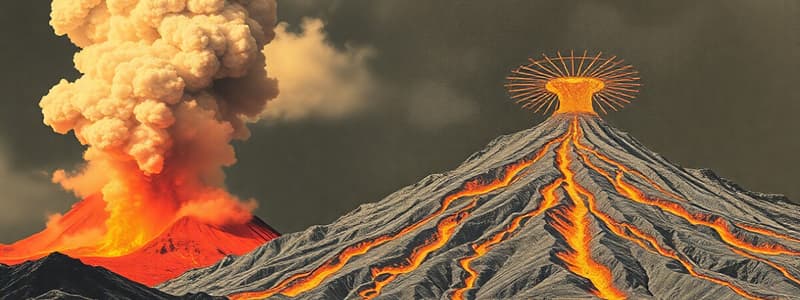Podcast
Questions and Answers
What are 'cold' pyroclastic surges and under what conditions do they occur?
What are 'cold' pyroclastic surges and under what conditions do they occur?
'Cold' pyroclastic surges are flows containing steam, water, and rock at temperatures less than 250 °C, which occur during eruptions from vents under shallow lakes or seas.
How can pyroclastic density currents interact with topography?
How can pyroclastic density currents interact with topography?
Pyroclastic density currents can flow over higher topographic features like ridges and hills due to their lower density.
What catastrophic event arose from the eruption of Mount Pelée in 1902?
What catastrophic event arose from the eruption of Mount Pelée in 1902?
The eruption of Mount Pelée in 1902 produced a fully dilute pyroclastic current that overwhelmed the city of Saint-Pierre, killing nearly 30,000 people.
What is the scientific abbreviation commonly used for pyroclastic density currents?
What is the scientific abbreviation commonly used for pyroclastic density currents?
Why are pyroclastic flows classified as gravity currents?
Why are pyroclastic flows classified as gravity currents?
What is a pyroclastic flow and how can it be produced by a Plinian eruption?
What is a pyroclastic flow and how can it be produced by a Plinian eruption?
In the context of a Vulcanian eruption, what causes the formation of a pyroclastic flow?
In the context of a Vulcanian eruption, what causes the formation of a pyroclastic flow?
Describe how frothing at the vent can contribute to the formation of ignimbrite.
Describe how frothing at the vent can contribute to the formation of ignimbrite.
What role does convection play in the production of pyroclastic flows?
What role does convection play in the production of pyroclastic flows?
How does the density of a pyroclastic flow compare to surrounding air?
How does the density of a pyroclastic flow compare to surrounding air?
Flashcards
Pyroclastic Flow
Pyroclastic Flow
A type of gravity current, sometimes abbreviated to PDC, involving a high-density flow of hot gas and volcanic fragments.
Pyroclastic Density Current (PDC)
Pyroclastic Density Current (PDC)
A high-density flow of hot gas and volcanic matter, a type of gravity current, often associated with volcanic eruptions
Cold Pyroclastic Surge
Cold Pyroclastic Surge
A pyroclastic density current with lower temperatures (still lethal) than other pyroclastic flows, possibly occurring from underwater eruptions.
Density
Density
Signup and view all the flashcards
Gravity Current
Gravity Current
Signup and view all the flashcards
Pyroclastic flow mechanism - eruption column collapse
Pyroclastic flow mechanism - eruption column collapse
Signup and view all the flashcards
Plinian eruption's role in pyroclastic flow
Plinian eruption's role in pyroclastic flow
Signup and view all the flashcards
Vulcanian eruption & pyroclastic flow
Vulcanian eruption & pyroclastic flow
Signup and view all the flashcards
Pyroclastic flow from vent degassing
Pyroclastic flow from vent degassing
Signup and view all the flashcards
Ignimbrite formation
Ignimbrite formation
Signup and view all the flashcards
Study Notes
Pyroclastic Flows
- Pyroclastic flow: a fast-moving current of hot gas and volcanic matter (tephra)
- Flows away from volcanoes, reaching speeds of 100 km/h to 700 km/h
- Temperatures reach 1,000°C (1,800°F)
- Most deadly volcanic hazard
- Speed depends on density, volcanic output rate, and slope gradient
- Can spread laterally or downhill due to gravity
Origin of Term
- Pyroclast: Greek words meaning "fire" and "broken in pieces"
- Nuée ardente (French): burning cloud, used to describe the 1902 eruption of Mount Pelée
Pyroclastic Surges
- Type of pyroclastic density current
- Higher gas-to-rock ratio
- Can flow over higher terrain or water
- May contain steam, water, and rock at temperatures of less than 250°C (480°F), though still lethally high
Causes of Pyroclastic Flows
- Eruption column collapse (Plinian eruptions): material ejected from vent heats surrounding air, rises, then falls down volcano flanks.
- Fountain collapse (Vulcanian eruptions): gas and projectiles create denser cloud than surrounding air.
- Lava dome collapse: collapses or explodes, causing avalanches.
- Directional blast: collapse or explode, causing a flow.
- Lava degassing/frothing: creating ignimbrite (rock).
Size and Effects
- Flow volumes range from a few hundred cubic meters to over 1,000 cubic kilometers
- Flows can travel hundreds of kilometers
- Typically 1-10 cubic kilometers and travel several kilometers
- Commonly consist of a basal flow and an ash plume
- Flatten trees and buildings
- Incinerate living organisms
- Can cross bodies of water
- Can generate lahars (volcanic mudflows) when interacting with water
Interaction with Water
- Pyroclastic flows can cross bodies of water
- Water evaporates, and the flow propels along a bed of steam
Studying That Suits You
Use AI to generate personalized quizzes and flashcards to suit your learning preferences.




